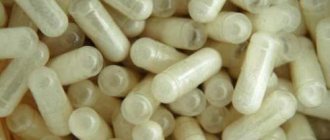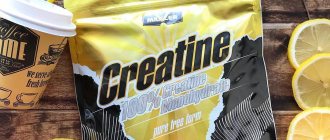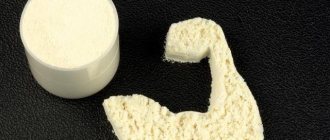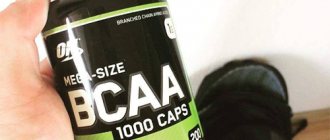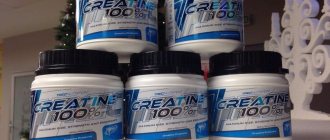3 July 2020 Admin Home page » Creatine
The concept of creatine with a transport system is described, the advantages and disadvantages, types of transport systems, important tips and conclusions are described.
TRANSPORT SYSTEM – is a combination of creatine with various substances that improve the absorption of creatine and its more complete and rapid delivery to the muscles . In addition to transport purposes, transport systems may have other features (anabolic effect, improved nutrition of muscle areas, etc.)
Content
- 1 Creatine with transport system
- 2 Types of transport systems 2.1 Creatine and carbohydrates
- 2.2 Creatine and protein (amino acids)
- 2.3 Creatine and Taurine
- 2.4 Alpha lipoic acid
- 2.5 L-arginine
- 2.6 L-glutamine
- 2.7 Creatine and D-pinitol
- 2.8 Creatine and vitamin E
- 2.9 Conclusion
- 3.1 Conclusion
Creatine with the transport system[edit | edit code]
Creatine with transport system
- a type of sports nutrition that combines creatine and substances that improve the absorption of creatine and accelerate its transport to the muscles. In addition to the transport function, transport systems can have individual effects (anabolic effect, improved muscle nutrition, etc.). Most creatines with a transport system (sports supplements) are included in the group of pre-workout complexes.
Most often, it makes sense to use creatine supplements with a transport system only on training days.
Creatine supplements with a transport system have virtually no disadvantages, except for the higher cost, and most importantly, they are reliably effective. Currently, there is no better choice of creatine supplement on the sports nutrition market than creatine with a transport system.
What is creatine for and why should you take it?
Creatine is used:
- in athletics;
- strength sports;
- in any type of wrestling;
- wherever explosive power of movements is needed.
This substance is extremely important for all living beings on the planet. In the body of an adult, it is usually only 100-140 grams. In normal life, a person loses approximately 2 grams of creatine per day per day (natural consumption). It is synthesized by our body from three amino acids: glycine, arginine and methionine.
With increased physical activity, the body's consumption of creatine increases. Therefore, additional intake is required. With nutrition, it can be obtained from all protein products: fish, meat, eggs, seafood and other animal products.
Types of transport systems[edit | edit code]
Efficiency of transport systems
There are a large number of additives of this kind, which vary not only in quality, but also in composition. And you can often find additives that are simply frightening due to the ignorance of the scientists who worked on their creation. All this is done to somehow stand out from the crowd and attract the attention of the buyer. But such “innovations” are very far behind in effectiveness compared to well-balanced creatine supplements with a transport system. When choosing the best supplement, first of all, pay attention to the form of creatine. It is better if it is creatine monohydrate. The most effective transporter substances will be discussed below in more detail.
Creatine and carbohydrates[edit | edit code]
Independent research conducted at Creighton University has documented the positive effects of the creatine and carbohydrate combination on exercise performance. These studies have shown that this combination provides an average 20 to 30% greater improvement in training performance than pure creatine.
Another interesting study conducted by Dr. Green and colleagues showed that in individuals taking a combination of creatine and carbohydrates, not only did the absorption of creatine into muscle cells improve by 50%, as Dr. Greenhaff had previously shown, but the formation of muscle glycogen also improved. This study also showed that performance increases even in athletes whose bodies do not respond to pure creatine.
- Type of research:
commercial and independent - Degree of trust:
high
Creatine and protein (amino acids)[edit | edit code]
Scientists have suggested that the stimulating effects of carbohydrates are associated with insulin, the level of which increases not only under the influence of carbohydrates, but also amino acids. Recent studies have confirmed that insulin is capable of increasing creatine accumulation in skeletal muscle, but only at concentrations close to or greater than 100 ml/l. Insulin-like factor 1 (IGF-1) has a similar effect.
The goal of a recent experiment by Dr. GR Stinge and colleagues was to determine whether consuming protein would increase creatine retention to levels seen with simple carbohydrates. The study results showed that taking creatine along with 50 grams of protein and 50 grams of carbohydrates was just as effective in stimulating insulin release and creatine retention as taking creatine with 100 grams of carbohydrates. That is, creatine can be mixed with a gainer. In this case, not only the summation of their actions will occur, but also mutual potentiation. Plus it's quite convenient.
Amino acids can be a good alternative to proteins. Their advantage is that they are lower in calories compared to proteins, and this is important for people losing weight; at the same time, they are absorbed much faster, since they do not require enzymatic catalysis, which leads to a powerful release of insulin, and this in turn helps facilitate the transport of creatine.
- Type of research:
commercial and independent - Degree of trust:
high
Creatine and Taurine[edit | edit code]
For bodybuilding, the most important properties of the variety of positive effects of taurine are its activating effect, which makes training more intense, and therefore improves athletic performance, faster recovery after training, and the ability to enhance insulin secretion.
Additionally, taurine has a direct anti-catabolic effect, which is why it is included in many creatine supplements to promote cellular volume and muscle growth.
- Research type:
commercial - Degree of trust:
low
Alpha lipoic acid[edit | edit code]
Alpha lipoic acid enhances insulin metabolism even in the presence of insulin resistance (insulin insensitivity). Insulin resistance is a condition in which the body produces enough insulin in response to elevated blood glucose levels, but does not respond properly to insulin. This disorder has become quite common these days (type 2 diabetes).
Alpha lipoic acid is included in a number of creatine transport systems because it has a powerful effect on insulin metabolism, even in people who have metabolic disorders.
- Research type:
commercial - Confidence level:
medium
L-arginine[edit | edit code]
Arginine takes an important part in nitrogen metabolism processes. Several qualitative properties of L-arginine provide powerful in-line delivery of creatine to muscle cells. L-arginine is a precursor for the synthesis of nitric oxide, which has pronounced vasodilating properties. This improves blood flow in the muscles for faster and more voluminous transport of nutrients, including creatine. The more blood flows through the muscle capillaries per unit of time, the more nutrients will be delivered to the muscle cells. Nitric oxide also helps lower blood pressure, which will be a good prevention of hypertension, which is quite common among weightlifters. Finally, nitric oxide increases sexual potency by improving blood flow to the genitals.
L-arginine increases insulin sensitivity, and this is the second important factor in accelerating creatine transport.
In addition, L-arginine activates the secretion of growth hormone, improves the body's immune function, reduces the healing time of injuries (including tendons), reduces the risk of heart disease, improves the reproductive properties of sperm and much more. Such a wide range of positive qualities of L-arginine simply cannot be overlooked, especially when it comes to bodybuilding.
There have also been studies that refute the benefits of L-arginine. They are described in more detail in the main article on arginine.
- Research type:
commercial - Degree of trust:
high
L-glutamine[edit | edit code]
The amino acid L-glutamine is an essential participant in insulin metabolism at the cellular level. Experiments have shown that supplementing the diet with L-glutamine can even prevent the onset of insulin imbalance in the body. L-glutamine is included in many creatine transport systems to promote cell volume and muscle growth. In addition, it prevents overtraining, improves brain function and, finally, is well known for its anti-catabolic and immune-boosting properties. In general, glutamine is one of the most common amino acids in the human body. Skeletal muscles consist of 60% of it. In addition, it makes up 20% of the structure of freely circulating amino acids.
- Research type:
commercial - Confidence level:
medium
Creatine and D-pinitol[edit | edit code]
D-pinitol is an herbal extract that has insulin-like properties. In a study by Dr. M. Greenwood and colleagues, it was found that consuming creatine with small doses of D-pinitol (2 times 0.5 grams per day) may increase creatine retention. However, consuming higher doses of D-pinitol (4 times 0.5 grams per day) did not increase creatine concentrations. Further research is needed.
- Research type:
commercial - Degree of trust:
low
Creatine and vitamin E[edit | edit code]
One recent study led by GB Gerber found that vitamin E promotes the absorption of creatine into muscles. The experiment was carried out on mice in which vitamin E deficiency was artificially induced. In this condition, at the initial stages, a higher level of free creatine in the serum was determined, compared with the control group, which then decreased to a level lower than in the control group. Scientists have concluded that the absorption of creatine into muscles decreases with a lack of vitamin E, as a result of which the pool of free creatine increases.
Conclusion[edit | edit code]
The most pronounced and proven effectiveness in accelerating the transport and absorption of creatine are carbohydrates and proteins (amino acids).
How to take creatine to gain muscle mass
If your body lacks protein foods, then creatine can provide invaluable help. Since creatine is sold in concentrated form, very little is needed to replenish energy costs. Just 5 grams of this valuable product after training can create a miracle of recovery for an athlete’s body.
Creatine is a product that should be included in the diet of those athletes whose results directly depend on the power and strength of the movements performed. Supplementing with creatine can significantly improve performance and increase explosive energy. You can start taking creatine:
- during serious preparatory training for competitions;
- in the process of increasing daily loads;
- against the background of weakening endurance;
- during the recovery period after illness;
- while mastering new programs and training;
- after long breaks from sports.
As soon as you feel that your energy and strength are running out, start taking creatine. Will creatine help you personally? This can only be determined experimentally.
Sports nutrition - creatine with transport system[edit | edit code]
Each athlete has two options: you can purchase creatine monohydrate - the most profitable and effective form of creatine, with a high price/quality ratio and combine it with the various transport systems listed above, or you can take a ready-made mixture of creatine and transport systems.
Currently, the sports nutrition market is replete with supplements that fall under the category of creatine with a transport system; almost every reputable company produces several types of such supplements. Most of them have a very diverse composition, which often includes more than 30 components, especially MuscleTech.
At first glance, this may seem attractive, but if you analyze the composition from a physiological and biochemical point of view, then such diversity is not always successful and advisable, since many components are poorly compatible, others are used in small doses that are not able to have the desired effect, some components In general it is better to take at different times and so on.
In addition, many supplements include cheap components (carbohydrates, such as maltodextrin), while the price increases several times. In these cases, it is much more profitable to take regular monohydrate and mix it with carbohydrates yourself; even regular sugar will do.
Conclusion[edit | edit code]
90% of all creatines with a transport system are a way of deceiving buyers by attracting their attention with the variety of composition and incredible effects; most of the components of such complexes (up to 95% of the composition) are generally ineffective. For less money, you can purchase several single-component supplements (for example: creatine monohydrate, glutamine, arginine), and the effectiveness will be almost the same as that of widely advertised complexes, and given the separate time of administration and the possibility of balancing doses, the effectiveness may be even higher.
Rating of the best creatines with a transport system[edit | edit code]
Despite the fact that the vast majority of complexes can be considered as unproven profanation, there are supplements worthy of attention that have a well-balanced composition, with synergistically interacting ingredients and a high price/quality ratio.
The best
- NO-Xplode from BSN
- Fierce from SAN
- NO Shotgun by VPX
Average
- Trac Extreme-NO from MHP
- Xpand Xtreme Pump by Dymatize
- Anabolic HALO from MuscleTech
